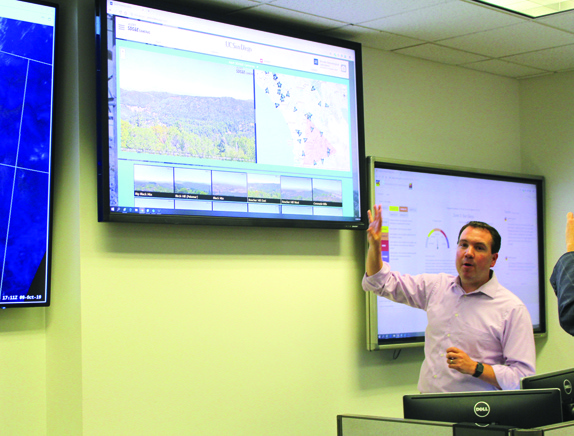In 2014, San Diego Gas and Electric began replacing older wood poles and visible power lines with new metal ones, simultaneously shifting electrical wires underground. The project was part of a larger $1.5 billion fire risk mitigation initiative that has been in place since 2007. Still, the company warned the public in eight different languages that it might cut power to over 10,000 customers last week to help prevent fire as Santa Ana winds flared up across San Diego county.
According to SDG&E, a spreading fire that comes in contact with any remaining poles and external wires could exacerbate an already dangerous situation.
SDG&E Director of Fire Science and Climate Adaptation Brian D’Agostino explained the science behind deciding which areas warrant an occasional shut-off during high-speed Santa Ana winds, using Pine Valley as an example.
“For example, you know how on East Willows road you get hit by that big wall of wind?… That’s one area we’re worried about. We’ve engineered the system so that where that wall of wind comes through… we have a line of wires on the right and in 2001 the Viejas fire started there. It wasn’t from our system but even in January it burned 10,000 acres,” D’Agostino said.
D’Agostino is part of a team which monitors county weather conditions, compiling data that is used by SDG&E in determining whether the company will shut off power to specific areas temporarily deemed at risk of wildfires. He says his team has a pretty good impression at about the 48-hour mark of whether a power shut-off would be a wise idea, but that conditions can change very quickly.
SDG&E Senior Communications Manager Zoraya Griffin says one thing the company has built up over the past two decades is an Emergency Operations Center that is only activated when the company initiates a power shut-off in the interest of public safety. When activated, that room is staffed with representatives from such varied sources as Customer Service and a retired Fire Chief working in 12-hour shifts.
The line of screens mounted high on the wall reflect data accumulated by the 190 weather stations set up throughout the county. At a glance, the monitors reveal captured information including temperature, wind conditions, a visual impression and changes in the coastal marine layer. D’Agostino said he is able to predict most weather patterns in San Diego county, and that the data being shown on the screens in the Emergency Operations Center reflects a wealth of information, especially when seen over time.
He also said the public is able to monitor that same information at alertwildfire.org, with some of the captured visual information also available as time lapsed data so that viewers can get a feel for how conditions look over time.
D’Agostino noted that sparks from cars very frequently seem to be the cause of fires but in the backcountry mountain areas of east county, it is especially important to monitor for critical fire conditions because no matter what the initial cause, the dry vegetation found throughout the area is quick-burning fuel.
“Fuels are generally a lot drier than they were in the past. Rainfall patterns seem to be shifting; they’re happening at different times of year. If it gets windy in October, it’s always dry and for 100 years this has posed a big risk— we know we’re here when the wind blows in October but usually November, December and May, it has rained and we’re out of the woods… and we haven’t been over the past ten years,” D’Agostino said.
He attributes that shift in rainfall patterns to climate change and explains that with the polar ice cap melting, the northern hemisphere is getting warmer and the winter time pattern is delayed. That leaves rains arriving later in the year, with the threat of gusts from a longer windy season potentially carrying a spark— from any source— into the dry brush of the backcountry.
Griffin said that the company regularly debriefs with local communities after public safety shut-offs have occurred, often with the goal of answering to the initial frustration of residents.
“Once we explain our decision making process, people walk away saying ‘I might not like it but I understand the decision’. This time of year, especially when we haven’t experienced a great deal of rain, residents need to be prepared,” Griffin said.












